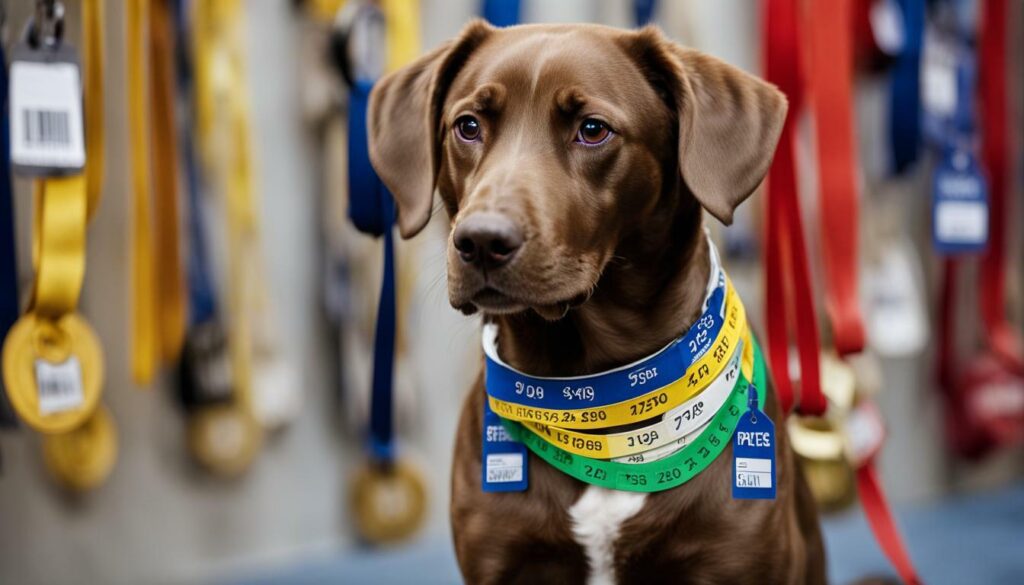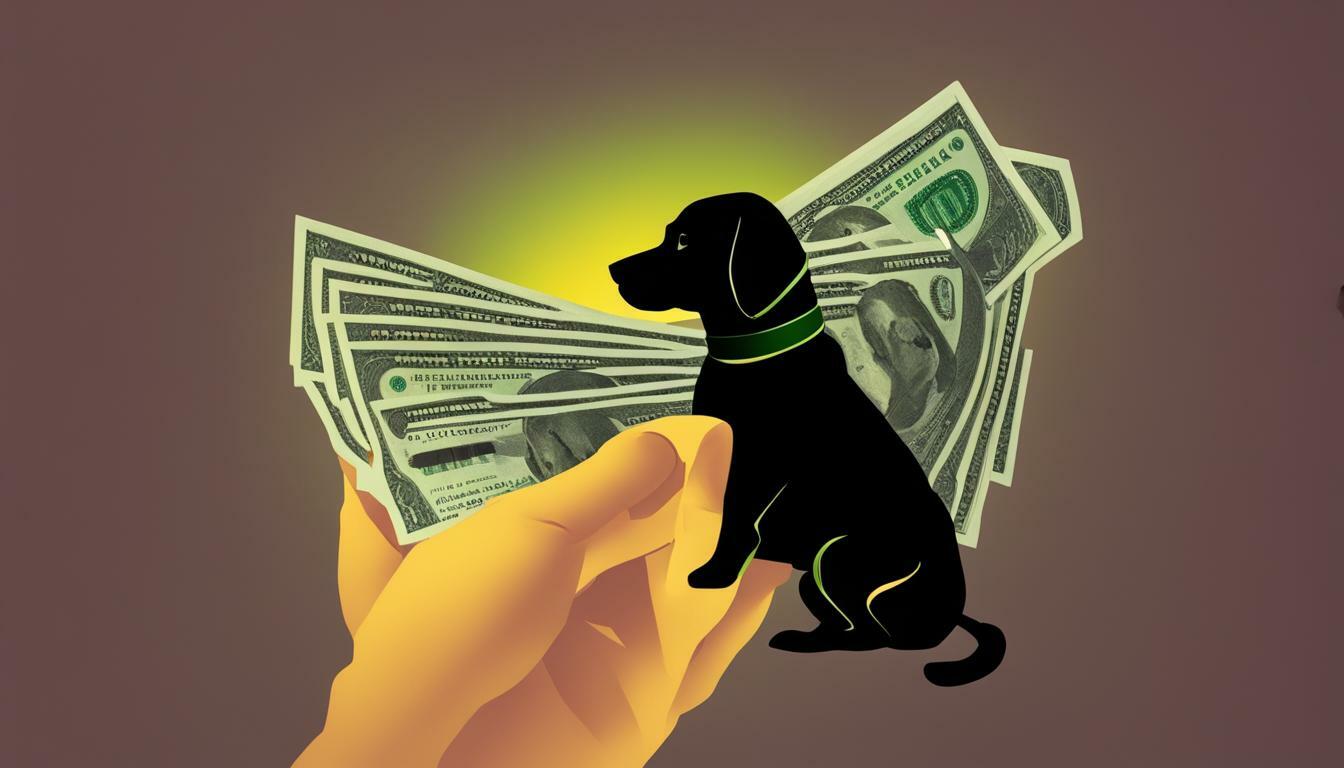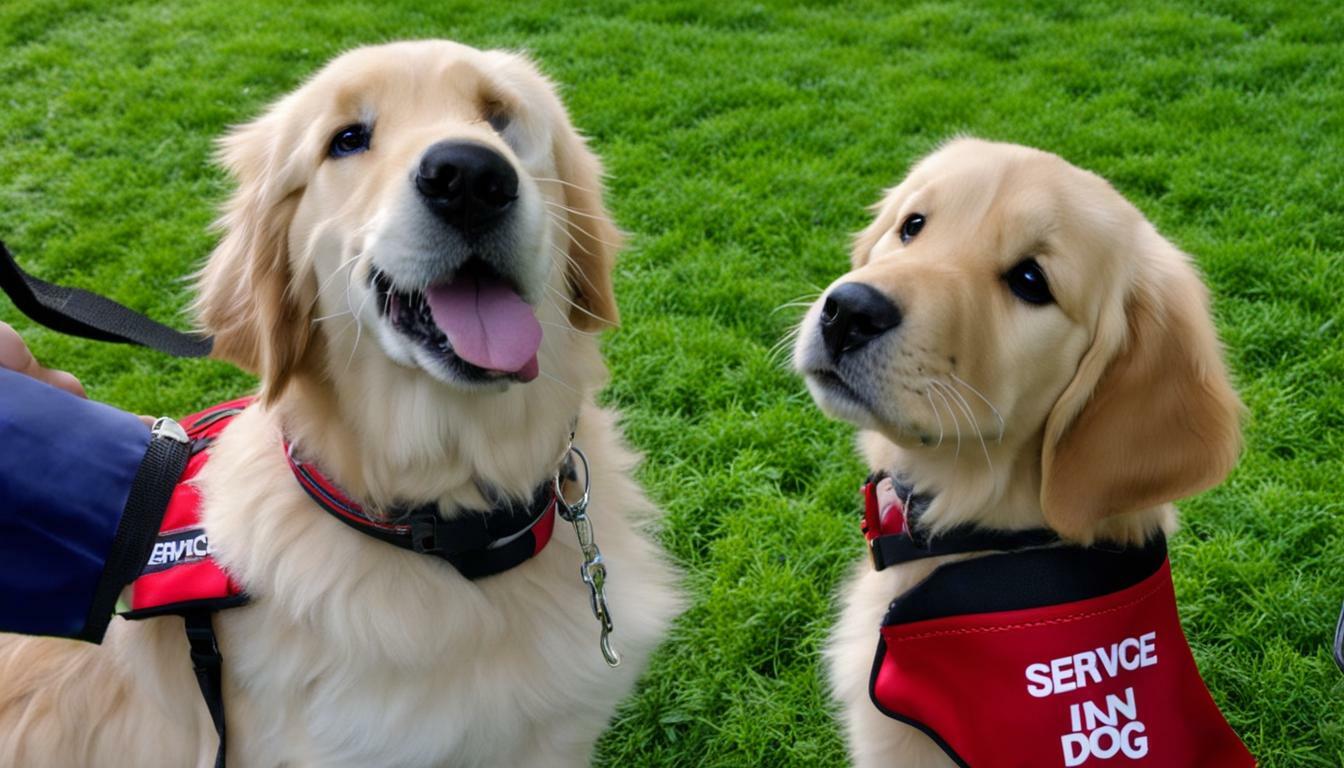Trained dogs can be a valuable addition to your family or business, but the price can vary greatly depending on several factors. When considering the cost of a trained dog, it’s essential to weigh the benefits and the investment, considering the training level, breed, and various other factors.
In this section, we’ll explore all the factors that impact the cost of a trained dog, to help you make an informed decision. From understanding different training levels to evaluating return on investment, we’ll provide you with expert insights to guide you through the process in a way that aligns with your budget.
Key Takeaways
- The cost of a trained dog can vary widely based on different factors, including training levels, breed, trainer’s experience, and other factors.
- It’s essential to research and select reputable trainers or organizations to avoid scams and unethical practices.
- Adopting a trained dog can be a more affordable option than purchasing a trained dog from a breeder or trainer.
- Long-term benefits and potential return on investment should be taken into consideration when considering the cost of a trained dog.
- Financing options are available for those who cannot afford the upfront cost of a trained dog.
Understanding Training Levels
When it comes to the cost of a trained dog, training levels are a significant factor to consider. The more advanced the training, the higher the cost.
Basic Obedience
Basic obedience training focuses on teaching a dog fundamental commands such as sit, stay, come, and heel. This type of training is suitable for most house pets and typically takes 4-6 weeks to complete. The cost of basic obedience training can range from $500 to $1,500 depending on the trainer’s experience and location.
Advanced Obedience
Advanced obedience training is appropriate for dogs that require more extensive training, such as those in law enforcement, search and rescue, or hunting. This training builds upon basic obedience and includes training for off-leash, hand signals, and increased control over the dog’s behavior. The cost of advanced obedience training can range from $1,500 to $5,000 or more.
Specialized Training
Specialized training is tailored to specific purposes such as guide dogs for the visually impaired, therapy dogs for emotional support, or service dogs for individuals with disabilities. This type of training can take up to 2 years and may require specialized skills or equipment. The cost of specialized training can range from $10,000 to $30,000 or more.
It’s essential to determine which training level is necessary for your dog’s intended role and budget accordingly. Keep in mind that training costs may also vary based on the breed of the dog and the trainer’s experience and reputation.

The breed of the dog can also have an impact on the price of a trained dog. Certain breeds are more commonly trained for specific tasks or services, which can result in a higher price. For example, German Shepherds and Labrador Retrievers are commonly used as police or military dogs, while Golden Retrievers and Labradoodles are popular choices for therapy dogs.
Besides the demand for certain breeds, availability can also impact pricing. Rare or exotic breeds may come with a higher price tag due to their limited availability.
| Breed | Common Purpose | Price Range |
|---|---|---|
| German Shepherd | Police, Military, Guard Dogs | $10,000 – $15,000+ |
| Labrador Retriever | Service, Therapy, Hunting Dogs | $5,000 – $10,000 |
| Golden Retriever | Therapy, Companion Dogs | $3,000 – $7,000 |
It’s important to note that while certain breeds may have a higher price range, the individual dog’s training and temperament will ultimately impact the final price. A well-trained dog of a less popular breed may still come with a high price tag if their skills and behavior meet a specific need.

In addition to training levels and breed, there are other factors that can contribute to the costs of a trained dog.
Trainer’s experience – The trainer’s experience can affect the cost of a trained dog. An experienced trainer who has worked with a variety of breeds and training levels may charge more than a novice trainer.
Location – The location of the trainer and the location where the training takes place can impact the cost. Urban areas may have higher prices due to the higher cost of living, while rural areas may charge less.
Duration of training program – The length of the training program can impact the cost of a trained dog. A program that lasts several weeks or months may cost more than a shorter program, as it requires more time and resources from the trainer.
When considering the costs of a trained dog, it’s important to keep in mind these additional factors that can contribute to the overall expenditure.

When considering the cost of a trained dog, it’s essential to take into account the training methods and techniques used. There are various approaches to dog training, and each trainer may have their own preferences.
Positive reinforcement is a popular methodology that rewards good behavior with treats or praise. This approach is effective and helps to build a strong relationship between the dog and trainer. However, some trainers may rely on punishment or aversion techniques, which can be harmful and may lead to aggressive behavior in the dog.
Another factor to consider is the use of equipment. Some trainers may rely on choke chains or shock collars, while others may prefer clickers or other positive reinforcement tools. It’s important to understand the equipment used and ensure that it aligns with your personal preferences and values.
Ultimately, the goal of any training method or technique should be to develop a happy, healthy, and well-behaved dog. When evaluating training methods and techniques, make sure to choose a trainer who shares this goal and employs safe, effective, and humane training methods.

Aside from the initial cost of a trained dog, it’s important to factor in ongoing expenses and maintenance. These expenses can include follow-up training sessions, veterinary care, and essential supplies. Depending on the type of training and the breed of the dog, the ongoing costs can vary. However, it’s essential to budget for these expenses to ensure that your trained dog remains healthy and well-behaved.
Follow-up training sessions are critical to maintaining your dog’s skills and behavior. These can be scheduled periodically, and the cost varies based on the length and frequency of the sessions. Additionally, veterinary care is essential to your dog’s health and longevity. Annual check-ups, vaccinations, and emergency care should be factored into your ongoing expenses. Preventative care such as medication for fleas, ticks, and heartworms is also necessary.
Along with veterinary care, you’ll need to purchase essential supplies such as food, toys, and grooming tools. These ongoing costs can add up, but they are necessary to keep your dog healthy and happy. It’s essential to budget for these expenses to ensure that you can provide the best care for your trained dog.

Other factors that can impact the ongoing expenses of a trained dog include the size and age of the dog. Larger dogs typically require more food and supplies, while older dogs may require additional medical care. It’s also important to consider any potential behavioral issues that may arise, as these can require professional intervention and additional expenses.
While the ongoing expenses of a trained dog may seem daunting, they are essential to keep your dog healthy and well-behaved. Proper budgeting and planning can help minimize these costs and ensure that your trained dog remains a valued companion for years to come.
Accreditation and Certification
When considering a trained dog, it’s essential to choose a trainer or organization with reputable certifications. Accreditation and certification can provide peace of mind that your dog has received proper training and care. Not only does this ensure that you are making a sound investment, but it also ensures that your dog receives humane treatment during training.
Trained dog fees may vary depending on whether the trainer or organization holds accreditations or certifications. Certified trainers or organizations are more likely to have higher fees due to their level of expertise and credibility. However, this investment is worth it in the long run, as your trained dog will have received the best possible care and expertise.
Do your research and ensure that your trainer or organization is accredited or certified by reputable organizations such as the International Association of Canine Professionals. Choosing an accredited or certified trainer or organization will give you peace of mind, knowing that your trained dog has received the best possible care and training.
Average Price Ranges
As discussed earlier, the cost of a trained dog can vary based on multiple factors, including the breed, training level, location, and other additional services. On average, the cost of a trained dog can range anywhere from $3,000 to $15,000 or more.
Basic obedience training can cost between $1,500 to $2,500, while advanced obedience training can range from $2,500 to $6,500. Specialized training, such as service or protection dog training, can cost upward of $10,000 or more. Breeds that are commonly used as working or service dogs, such as German Shepherds or Labradors, usually come with a higher price tag due to their demand and availability.
Trainer experience and location can also play a role in pricing, with training programs in major metropolitan areas often costing more than those in smaller cities. Additional services such as follow-up training sessions, veterinary care, and essential supplies can add to the overall cost of owning a trained dog.
It’s essential to keep in mind that while the upfront cost of a trained dog may seem significant, the long-term benefits and ROI can outweigh the investment. A well-trained dog can provide invaluable assistance and companionship for many years to come, making it a worthwhile investment for those who can afford it.

When considering the cost of a trained dog, be sure to research and compare pricing across different organizations and trainers to ensure you are getting a fair price. Keep in mind the additional expenses that come with owning a trained dog, such as veterinary care and specialized equipment.
Next, we’ll explore financing options for those who may need assistance in affording a trained dog.
Budgeting and Financing Options
Investing in a trained dog can be a significant expense, and it’s essential to budget and plan accordingly. If the upfront cost falls outside your immediate budget, several financing options are available.
Many reputable trainers and organizations offer payment plans or financing options to make trained dogs more accessible. Be sure to inquire about these options when researching potential trainers or organizations. Other financing options include personal loans, credit cards, or crowdfunding campaigns.
It’s important to weigh the costs and benefits of each financing option to determine which is the best fit for your financial situation. Consider the interest rates and any associated fees, as well as the impact on your credit score.
While financing can help make a trained dog investment more manageable, it’s crucial to remember that the upfront cost is just the beginning of the expenses. Ongoing expenses, such as veterinary care, food, supplies, and additional training, should also be factored into your budget.
By carefully researching and budgeting for a trained dog and considering financing options, you can make an informed decision and give your new companion the care and attention they deserve.

Unfortunately, the market for trained dogs is not immune to scams and unethical practices. It’s crucial to be aware of these risks and take steps to avoid them.
One common tactic used by fraudulent trainers is to offer unrealistically low prices for trained dogs. They may also make false promises or guarantees about a dog’s abilities or temperament. Be cautious of any trainer or organization that seems too good to be true.
Another warning sign is if a trainer insists on full payment upfront or pressures you into making a quick decision. A reputable trainer will usually offer payment plans and allow for time to make an informed decision.
Before committing to a trainer or organization, do your research. Look for reviews and testimonials from previous clients, and ask for references. Reputable trainers should be happy to provide references and have nothing to hide.
It’s also essential to choose a trainer or organization with proper accreditation and certification. Accreditation from organizations such as the International Association of Canine Professionals (IACP) or the Certification Council for Professional Dog Trainers (CCPDT) ensures that the trainer has undergone rigorous training and adheres to ethical standards.
By taking these precautions, you can avoid scams and unethical practices and ensure that your investment in a trained dog is a safe and worthwhile one.

One of the most critical considerations when purchasing a trained dog is selecting a reputable trainer or organization. Unfortunately, the market for trained dogs is not immune to scams and unethical practices. Therefore, thorough research is necessary to avoid falling prey to fraudulent trainers or organizations.
Start by asking the right questions. A reputable trainer or organization should be willing to provide references, client testimonials, and information on their training methods and techniques. Additionally, inquire about their certifications and accreditation, as it indicates their level of expertise and professionalism.
When researching trainers or organizations, it’s essential to look beyond their website and social media presence. Check online reviews and ratings from credible sources such as Google reviews or the Better Business Bureau. Furthermore, reach out to previous clients to gain insight into their experiences with the trainer or organization.
It’s also crucial to ensure that the trainer or organization is transparent about their fees and pricing structures. Avoid trainers or organizations that are vague or unwilling to disclose their pricing upfront.
By performing thorough research and due diligence, you can ensure that you’re selecting a reputable trainer or organization that will provide you with a well-trained dog at a fair price.

Investing in a trained dog requires a significant upfront cost. However, it’s crucial to consider the long-term benefits and potential return on investment. Firstly, a trained dog can improve your overall quality of life by providing emotional support and companionship. Additionally, a service dog can assist with daily tasks and mobility, providing a greater sense of independence and freedom. Moreover, a trained dog can serve a specific purpose, such as a working dog, which can enhance productivity and potentially lead to increased revenue for businesses.
While the potential return on investment may vary for each individual, it’s important to consider the non-monetary benefits of owning a trained dog. However, it’s crucial to evaluate the financial return as well. For example, a service dog can allow an individual to return to work or increase their productivity, potentially leading to increased income. Additionally, a well-trained guard dog can provide added security and potentially lower insurance costs for businesses or homeowners.
When evaluating the return on investment for a trained dog, it’s important to consider both the immediate and long-term benefits. While the upfront cost may seem significant, the long-term benefits can far outweigh the initial expenditure. Ultimately, the decision to invest in a trained dog should be based on careful consideration of the potential benefits and drawbacks.

When considering the cost of a trained dog, it’s important to remember that it’s an investment in both yourself and your future. While the initial expense may seem daunting, the long-term benefits and potential return on investment can make it a worthwhile decision.
Considerations for Specific Needs or Tasks
The cost of a trained dog can also vary depending on your specific needs or tasks. For example, therapy dogs are often trained to provide comfort and support to individuals with mental or emotional disabilities, while service dogs are trained to perform specific tasks for individuals with physical disabilities. Working dogs, such as police or search and rescue dogs, undergo specialized training for their respective roles. The training required for these types of dogs may be more extensive and therefore more costly than basic obedience training.
When considering a trained dog for your specific needs or tasks, it’s essential to evaluate the necessary training and factor in the associated costs. The price of a trained dog may also vary depending on the breed and temperament required for the job or task at hand.
It’s important to have a clear understanding of your requirements and budget before investing in a trained dog for a specific job or task. This ensures that you find a dog that is both capable and appropriately trained for your specific needs, while also staying within your budget. Additionally, factoring in ongoing expenses, such as veterinary care and other maintenance costs, is crucial when considering the expenditure associated with owning a trained dog.

The cost of a trained dog for specific needs or tasks can vary significantly, so it’s essential to research and evaluate your options carefully. This can involve seeking out reputable trainers or organizations with experience in training dogs for your particular requirements, as well as requesting references and inquiring about their training methodologies and techniques. By making an informed decision, you can ensure that you invest in a trained dog that meets your specific needs, stays within your budget, and provides ongoing benefits and value.
Adopting a Trained Dog
If the cost of a trained dog from a breeder or organization is out of your budget, adoption may be a more affordable option. Many rescue organizations train dogs for specific purposes, such as service or therapy work, and offer them for adoption at a lower cost than a breeder or trainer. Additionally, adoption fees often cover essential veterinary care and initial training.
When considering adopting a trained dog, it’s important to research and select a reputable rescue organization. Look for organizations with experience in training dogs for specific purposes and ask for references or testimonials from previous adopters. You can also check with animal shelters or other rescue organizations in your area for recommendations.
It’s important to note that while adopting a trained dog may seem like a cost-effective option, there may be additional expenses to consider. Ongoing veterinary care, grooming, and supplies such as food and toys can add up over time. However, the cost of these expenses is typically much lower than the cost of purchasing a trained dog from a breeder or trainer.

Adopting a trained dog can be a rewarding and cost-effective way to add a furry companion to your family. By choosing a reputable rescue organization and factoring in the potential ongoing expenses, you can ensure that you make an informed decision and give a loving home to a trained dog in need.
Making an Informed Decision
When evaluating the cost of a trained dog, it’s important to consider all the factors discussed in this article. Remember that the price can vary greatly depending on the breed, training level, and other associated costs.
Before making a decision, ensure that you have thoroughly researched and evaluated the trainer or organization offering the trained dog. Look for certifications and inquire about their training methods and experience. Ask for references and follow up with them.
Work Within Your Budget
It is essential to work within your budget when purchasing a trained dog. Consider financing options, but ensure that you have the means to make regular payments. Adopting a trained dog may also be a more affordable option; research reputable rescue organizations that specialize in trained dogs.
Think Long-Term
Remember that owning a trained dog involves ongoing expenses and maintenance. Consider the potential long-term benefits of owning a trained dog and evaluate the return on investment. Keep in mind that a trained dog can provide emotional support, therapy, and even assistance with specific tasks.
Making an informed decision requires careful consideration of all the factors involved in owning a trained dog. Take your time to research, evaluate your budget, and think long-term. With the right trainer or organization and a well-trained dog, the investment can provide immense joy and value to your life.
FAQ
How much is a trained dog?
The cost of a trained dog can vary depending on several factors, including training levels, breed, and other factors. We’ll explore these factors in detail to help you understand the price of a trained dog.
What are the different training levels?
Training levels play a significant role in determining the cost of a trained dog. We’ll explain the different levels, such as basic obedience, advanced obedience, and specialized training, and how they impact the overall price.
How does the breed affect the price of a trained dog?
The breed of the dog can influence the cost of a trained dog. Certain breeds are more sought after for specific tasks or services, resulting in higher prices. Additionally, the demand and availability of certain breeds can impact pricing.
What are the factors that affect training costs?
Besides training levels and breed, other factors contribute to the overall cost of a trained dog. These factors include the trainer’s experience, location, and the duration of the training program.
How do different training methods impact the cost of a trained dog?
The training methods and techniques used can affect the price of a trained dog. We’ll explore different methodologies and discuss how they can influence the overall cost.
What are the additional services and maintenance costs associated with owning a trained dog?
Owning a trained dog involves ongoing expenses and maintenance. We’ll examine additional services such as follow-up training sessions, veterinary care, and essential supplies, which should be considered when calculating the overall cost.
How does accreditation and certification affect the price of a trained dog?
Accreditation and certification can impact the cost of a trained dog. Choosing a trainer or organization with reputable certifications can contribute to the overall price.
What are the average price ranges for trained dogs?
In this section, we’ll provide an overview of the average price ranges for trained dogs based on the factors discussed earlier. This will give you a general idea of what to expect when looking for a trained dog.
Are there financing options available for purchasing a trained dog?
If the cost of a trained dog falls outside your immediate budget, there are financing options available. We’ll explore different financing options that can help you afford the trained dog you desire.
How can I avoid scams and unethical practices when purchasing a trained dog?
Unfortunately, the market for trained dogs is not immune to scams and unethical practices. We’ll provide guidance on how to identify and avoid fraudulent trainers or organizations to ensure you make a safe and informed investment.
What should I consider when researching trainers and organizations?
When considering a trained dog, it’s crucial to research and select reputable trainers or organizations. We’ll guide you through the research process, including asking the right questions and seeking references, to make an informed decision.
How can I evaluate the return on investment for a trained dog?
While the upfront cost of a trained dog may seem significant, it’s important to consider the long-term benefits and potential return on investment. We’ll explore the various ways a trained dog can enhance your life and explain how it can be seen as an investment.
What considerations should I take into account for specific needs or tasks?
Depending on your specific needs or tasks, the cost of a trained dog may vary. We’ll discuss considerations for different purposes, such as therapy dogs, service dogs, or working dogs, and how these factors impact the price.
Is adopting a trained dog a more affordable option?
Adoption can be a more affordable option for obtaining a trained dog. We’ll explore the potential cost savings of adopting a trained dog and discuss the process of adopting a trained dog from reputable rescue organizations.
How can I make an informed decision when considering the cost of a trained dog?
In this final section, we’ll summarize the key points discussed throughout the article and provide practical tips to help you make an informed decision when considering the cost of a trained dog.

Marissa Delotta, 36, from Dayton, Ohio, is the creative force behind Roverboard.com, a beloved online destination for dog lovers. As a dedicated mom and canine enthusiast, Marissa combines her family experiences with her love for dogs to offer a platform where dog owners can exchange tips, heartwarming stories, and advice. Her website has become a vibrant community for sharing the joys of dog parenting. In her free time, Marissa enjoys exploring dog parks with her family and volunteering at local animal shelters.





